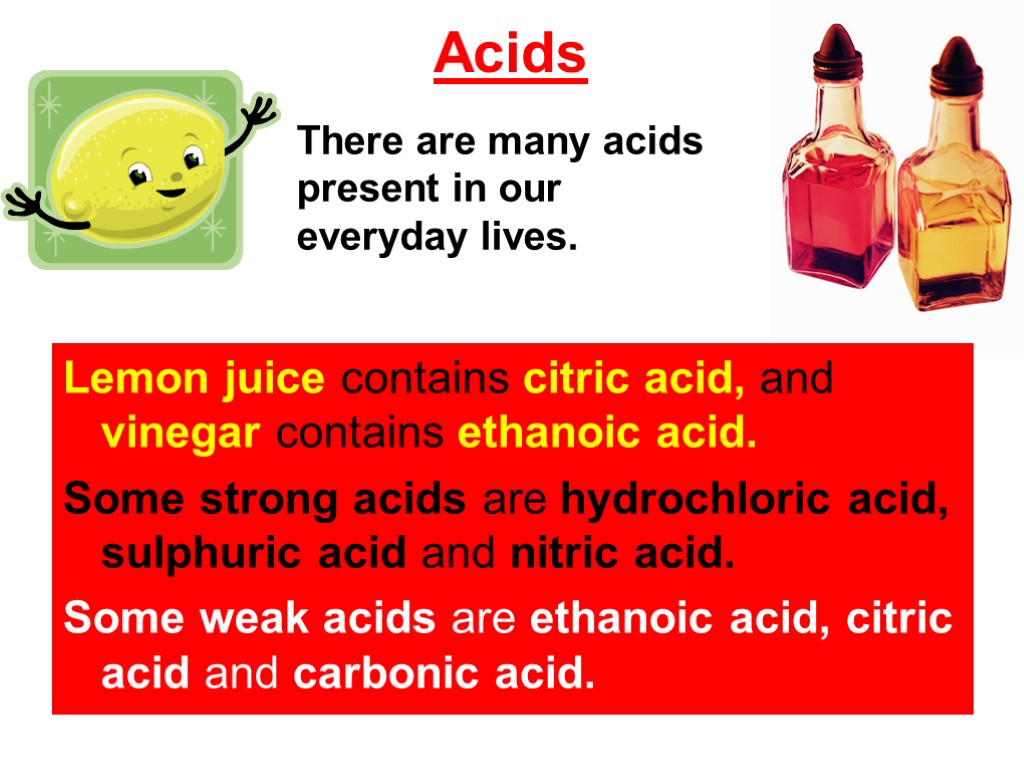Acids and Alkalis Learning Objectives To know that


Acids and Alkalis Learning Objectives To know that solutions can be sorted by whether they are: acid, alkali or neutral. To understand that an alkali reacts with an acid to cancel it out. To know that indicators show you how acidic or alkaline a solution is.

Acids and alkalis Solutions can be sorted by whether they are: acid, alkali or neutral. When a substance dissolves in water it makes a solution.

When the oxide of some non-metals dissolve in water they make an acid. Acids have a sour taste. They are corrosive.

Acids react with metals and carbonates. Metal + Acid Salt + Hydrogen magnesium + magnesium chloride + hydrochloric acid hydrogen Acid + Carbonate Salt + Water + Carbon dioxide sulphuric acid + copper sulphate + water + copper carbonate carbon dioxide

Acids Lemon juice contains citric acid, and vinegar contains ethanoic acid. Some strong acids are hydrochloric acid, sulphuric acid and nitric acid. Some weak acids are ethanoic acid, citric acid and carbonic acid. There are many acids present in our everyday lives.

Neutralisation Acids and alkalis react with each other. The alkali cancels out the acid in the reaction. This is called neutralisation. A salt is made.

Salts The salt made depends on the acid and alkali used. The salt contains the metal atom from the alkali, and part of the acid molecule. The salts of sulphuric acid are known as sulphates. The salts of hydrochloric acid are known as chlorides. The salts of nitric acid are known as nitrates.

Alkalis When the oxides of some metals dissolve in water they make an alkali solution. Alkalis react with acids and neutralise them. Many everyday substances are alkalis. They feel soapy. They are corrosive.

Alkalis Alkalis are present in many cleaning substances in use in our homes. Kitchen cleaners are alkaline because they contain ammonia or sodium hydroxide, which attack grease. Calcium hydroxide and sodium hydroxide are strong alkalis. The most recognisable and common weak alkali is ammonia.

Indicators They change colour in acid or alkaline solutions. Different indicators change to different colours. Indicators help you find out whether a solution is acidic or not.

Litmus Test Litmus is an indicator. It changes colour in acid and alkaline solutions. Litmus is red in an acid. Litmus is blue in an alkali.

Universal Indicator Universal indicator changes colour in acids and alkalis. Its colour shows the strength of an acid or alkali. ACIDS ALKALIS Neutral

The pH scale 1 – 6 8 - 14 Alkalis 7 Neutral Acids

Applications of Neutralisation Indigestion: Our stomach carries around hydrochloric acid. Too much of this leads to indigestion. To cure indigestion, you can neutralise the excess acid with baking soda or specialised indigestion tablets. Insect Stings Bee stings are acidic and can be neutralised with baking soda (bicarbonate of soda). Wasp stings are alkaline and can be neutralised with vinegar.

More Applications of Neutralisation Factory Waste: Liquid waste from factories is often acidic. If it reaches a river it will destroy and kill sea life of many forms. Neutralising the waste with slaked lime can prevent this. Soil Treatment: When soils are too acidic (often as a result of acid rain) they can be treated with slaked lime, chalk or quicklime, all alkalis. Plants and crops grow best in neutral soils.
acids_and_alkalis_ppt.pptx
- Количество слайдов: 15

